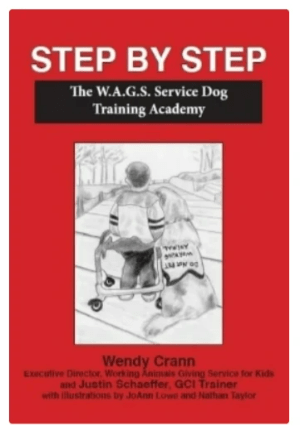At W.A.G.S. 4 Kids, we're often asked about how we train our service dogs to behave so well. The answer: our founder spent years and years working with dogs and developing a successful method of training that all of our dogs now partake in.
Today, our staff trainers, Lisa, Josh, and Rodney, teach these methods to our inmate trainers at the Mansfield and Grafton Correctional Institutions, who in turn help train the service dogs in our program. In celebration of National Dog Training Month, we're sharing with you some of the basic training methods we use to work with our service dogs in training.

Name Good Behaviors
One of the most important things to remember during training is that dogs are animals of behavior - not language. Here at W.A.G.S. 4 Kids, we tend to say "dogs don't speak English." Words like "sit," "down," "stay," or "leave it" have no meaning to your dog until you pair those words with behaviors.
Staring at your dog and repeating "sit, sit, sit" until they do so isn't going to teach your dog much of anything. They have no behavior to pair with the command "sit," and so they are just hearing a word without understanding what it really means.

Instead of repeating "sit" until your dog does so, name the command after your dog naturally sits. Don't worry - every dog will naturally sit. When they do sit on their own, that is when you name the command "sit." With time and repetition, the dog will learn that the behavior of sitting corresponds with the word "sit."
You can use this method of naming good behaviors for multiple commands, including "down," "off," "heel," and more.
Talk Less and You'll Smile More
One of the hardest things to teach yourself when training your dog is to talk less. What we mean by this is that you should only talk to your dog when commanding them.
This means not having conversations with your dog, such as asking them if they want dinner, asking how their day was when you get home, or even telling them how much you love them. Your voice should be saved for commanding your dog.

Many people find this difficult to do because they believe that conversing with their dog is a sign of affection. But remember, dogs don't speak English. Showing affection to your dog is as easy as petting them, rubbing their belly, and just giving them your attention!
Name only good behaviors - don't tell your dog "no" or "stop." If your dog is barking, and you tell them to "be quiet," you are giving a name to a bad behavior. Often, when your dog exhibits a bad behavior, one of the best things to do is simply ignore them. For example, if they begin to jump at your leg, ignore them by turning away and they will realize that the behavior they are exhibiting won't result in the attention they want!
As you reward your dog for tasks that they successfully perform and ignore your dog when they display unwanted behaviors, they will begin to understand what actions will earn them praise, and will perform those actions more commonly and willingly!
Think In Terms of What You Want
People who are training their dogs often think in terms of what they don't want. They don't want their dog to beg at the table or they don't want their dog to bark at the door or they don't want their dog to jump on the furniture. We believe that for every bad behavior that you don't want your dog to exhibit, there is a behavior that you do want your dog to exhibit.

For example, let's say that you don't want your dog to beg for food at the dinner table. Think in terms of what you want to train your dog to do instead. You can train your dog to sit on their bed whenever you are in the dining room eating dinner, meaning that they won't be begging for food. Instead of training your dog to not beg for food (something you don't want), you are training them to lay in their own space during mealtimes (something you do want).
Training your dog to not engage in unwanted behaviors starts with teaching and reinforcing wanted behaviors!
Educate Yourself to Best Educate Your Dog
The few tips that we've provided here only scratch the surface when it comes to training your dog. Our trainers have spent their careers learning the best ways to train our dogs to be remarkably well behaved, task-trained service animals. When inmates join our Accredited Cell Dog Training Program, they are given the book "Step By Step: The W.A.G.S. Service Dog Training Academy." This book was written by our founder, Wendy Crann, with assistance from former GCI Trainer Justin Schaeffer, and has been used by both our inmates and other individuals to produce amazing training results.
One of the best ways to ensure that you are teaching your dog to perform their very best is to educate yourself on what you should and shouldn't do during training. We don't only recommend "Step By Step" for training service dogs, we also recommend the book for teaching your pet basic obedience and good manners. Most of all, it will teach you how to become an effective trainer who will be able to form a strong partnership with your dog.
A physical copy of "Step By Step: The W.A.G.S. Service Dog Academy" can be purchased online here, or downloaded as an e-book here, with a majority of the proceeds going right back to W.A.G.S. 4 Kids!


